Triple cropping and diverse landscape enhance biological pest control and productivity in vegetable fields
Abstract
Insect herbivores cause substantial economic loss to agricultural crops and insecticides are the foremost strategy in their management. Increasing crop diversity is expected to improve biological control services and primary productivity. However, the benefits of mixing more than two annual crop species remain poorly understood. Using okra (Abelmoschus esculentus), calabash (Lagenaria siceraria), and sponge gourd (Luffa acutangular), we compared the effect of double and triple cropping to monocropping on insect herbivore and predator abundance and diversity and the number of marketable fruits as yield in nine fields over 2022 and 2023 in Pakistan. We found 21 insect species, including 9 species of herbivores and 12 species of predators. Herbivore abundance of almost all species was significantly lower while predator abundance of all species was significantly higher in triple cropping. Herbivore richness was significantly and positively correlated with increasing vegetable diversity while a non-significant relation was noted for herbivore diversity and dominance. Predator diversity, richness and dominance were significantly and positively correlated with increasing crop diversity. Increasing landscape diversity (Shannon diversity) significantly reduced pest abundance and increased the diversity of pests and predators as well as predator abundance. Predator abundance and diversity matrices played a significant role in herbivore suppression suggesting a strong top-down effect. Number of fruits was higher in triple cropping. Path analyses proved that herbivore abundance affected the yield indirectly through predator diversity. Our results suggest that local and landscape diversity and complementarity among crop species and predator species are simultaneously regulating biological control and primary productivity in vegetable diversity gradient.

 求助内容:
求助内容: 应助结果提醒方式:
应助结果提醒方式:


